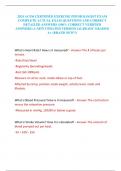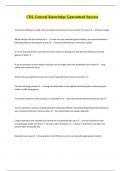2024 ACSM CERTIFIED EXERCISE PHYSIOLOGIST EXAM
COMPLETE ACTUAL EXAM QUESTIONS AND CORRECT
DETAILED ANSWERS (100% CORRECT VERIFIED
ANSWERS) A NEW UPDATED VERSION |ALREADY GRADED
A+ (BRAND NEW!!)
What is Heart Rate? How is it measured? - Answer-The # of beats per
minute.
-Rate (fast/slow)
-Regularity (bounding/weak)
-Rest (60-100bpm)
Measure on wrist, neck, inside elbow or top of foot.
Affected by temp, position, body weight, activity level, meds and
lifestyle.
What is Blood Pressure? How is it measured? - Answer-The contraction
versus the relaxation pressure.
-Measured in mmHg, 120/80 or below is good.
What is Stroke Volume? How it is calculated? - Answer-The amount of
blood pumped out per beat.
-SV = EDV - ESV
,What is Cardiac Output? How is it calculated? - Answer-The amount of
blood pumped out per minute.
-Q = SV X HR
What is Hypertension? - Answer-When the amount of blood being
pumped out by the heart is too HIGH which can lead to MI or stroke.
-Asymptomatic
-HIGH arterial pressure
-140/90+
Name the short-term effects of cardio & resistance training. - Answer--
Increase of HR, SV, Q, O2 demand, pH and BF
Name the long-term effects of cardio & resistance training. - Answer--
Decrease in HR, BP
-Increase in SV @ rest, # of capillaries, RBCs, Q, BV
Difference b/w warm-up & cool down. - Answer-Warm-up: BEFORE,
large muscle groups, increase BF, body temp, decrease soreness and
injury risk.
Cool down: AFTER, continuation of workout, recovery, steady state,
decrease HR, BP, BF.
,Explain DOMS (Delayed Onset Muscle Soreness) - Answer-Acute
soreness, b/c of large unaccustomed force on eccentric movements,
microtears, lasts 12-72 hrs.
What is BMI? How is it calculated? - Answer-(kg-m); anthropometric
measurement used to asses weight relative to height and is calculated
by dividing the weight (kg) by height (m).
25+ (overweight)
30+ (obese)
35+ (morbidly obese)
What is maximum HR? How is it calculated? - Answer-The HR increase
linearly as workload increases and has reached a max point.
-Karvonen Formula (220-age)
What is Karvonen Formula? - Answer-A formula used to determine max
and resting HR with the desired exercise training intensity to get a
target heart rate.
What are the three types of muscle? - Answer-Smooth, Cardiac,
Smooth
What is the function of prime movers (agonists)? - Answer-Agonist,
active, eccentric, and a major force of specific movement.
, What is the function of the antagonists? - Answer-Oppose prime
movers, stretch reflex and includes active relaxation.
What is the function of the synergist? - Answer-Cross multiple joints,
prevents unwanted action and known as a fixator & anatagonist.
What is the function of the fixator? - Answer-Stabilizer of proximal
joints.
Explain the Sliding Filament Theory. - Answer-Explains how muscles
produce force and contractions occur which shorten the muscle. The
thick filaments are myosin and the the thin filaments are actin. Both
filaments are within the sarcomere and slide past one another,
shortening the entire length of the sarcomere.
What is Trp? (Troponin) - Answer-Controls Trm, regualated by Calcium
and is involved in the cross-bridging cycle.
What is Trm (Tropomyosin)? - Answer-Controlled by Trp,covers myosin
binding sites and inhibits muscle contraction.
What is an isometric contraction? - Answer-Same distance, no
movement, no changes in muscle length.





